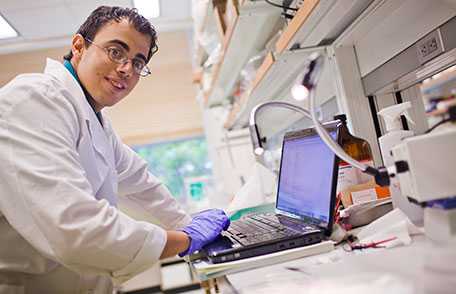Living with Thalassemia

Did you know that beta thalassemia major, the most severe form of thalassemia, affects at least 1,000 people in the United States? By staying committed to long-term treatment, people with thalassemia can enjoy a full life.
Thalassemia is a group of blood disorders passed from parents to children through genes (inherited). A person who has thalassemia makes fewer healthy red blood cells. Their red blood cells do not produce enough hemoglobin, the protein that carries oxygen throughout the body. People with severe thalassemia can have various medical complications. They might also require lifelong blood transfusions for treatment.
Living with Thalassemia
Specialized care across the lifespan can help people who have thalassemia live as healthily as possible. Thalassemia is a treatable disorder that can be well-managed with blood transfusions and chelation therapy. A person with thalassemia will need to receive medical care on a regular basis from a hematologist (a medical specialist who treats diseases or disorders of the blood). If a doctor has prescribed either blood transfusions or chelation therapy, the most important thing a person with thalassemia can do is stick to their treatment schedules to prevent severe anemia (low numbers of red blood cells) and possible organ damage from iron overload.
Robert’s Story
Robert Mannino knows more about blood transfusions than most people. Since he was only six months old, he has spent much of his life in clinics, receiving transfusion therapy for beta-thalassemia. Thalassemia—there are two types known as alpha-thalassemia and beta-thalassemia–are inherited blood disorders. The red blood cells of a person with thalassemia don’t make enough of a protein called hemoglobin, which carries oxygen in the blood to all the parts of the body. Thalassemia is a treatable blood disorder that can be well-managed with
- Blood transfusions (the process of receiving blood or blood products into one’s veins to replace lost components of the blood) and
- Chelation therapy (medicine to remove excess iron from the body).
Robert credits his parents with the strength he came to eventually develop in himself to manage his condition. “At the time I was born, we were living in Kansas City. I was initially diagnosed incorrectly as having iron-deficient anemia, but eventually a hematologist, a doctor who specializes in blood disorders, came to the correct diagnosis of beta-thalassemia.” Shortly after this diagnosis, Robert and his family moved to Atlanta. By age 4, Robert was seen routinely at a major children’s hospital in Atlanta by a hematologist with expertise in treating thalassemia. Robert envisions his young parents at the time, struggling to learn all they could about a blood disorder as rare as thalassemia and determining how to find the right care for their son. Ultimately, Robert was fortunate to be seen by the same pediatric hematologist from age 4 to age 22, when he transitioned to a clinic that specializes in the diagnosis and treatment of adults with blood disorders.
Robert credits this consistent, outstanding care with making a vital difference in his life. His pediatric hematologist always encouraged him to ask questions about his condition. “The opportunity to question things led me to better understand thalassemia. This ultimately led to my interest in choosing science as a field of study.”
Now 25 years old, Robert is studying in a biomedical engineering PhD program that is a joint initiative between the Georgia Institute of Technology and Emory University. “I’ve always been interested in science and math,” says Robert. “I’ve spent a great deal of time in the hospital growing up and getting to know others with blood disorders. Now I now want to use my talents to help others.”
Read more about Robert’s story.
CDC’s Work
CDC’s National Center on Birth Defects and Developmental Disabilities conducts the following activities:
Blood Safety Monitoring for People with Blood Disorders
CDC funds one project that monitors blood safety in people with blood disorders. This project is called “Characterizing the Complications Associated with Therapeutic Blood Transfusions for Hemoglobinopathies.” Georgia State University, the University of Florida, and the University of California at San Francisco Benioff Children’s Hospital Oakland have been awarded funding to look at transfusion-related complications in people with hemoglobin disorders (sickle cell disease and thalassemia) and develop approaches for reducing these complications.
Health Promotion
To better understand the challenges of keeping up with thalassemia treatment, CDC funded the Cooley’s Anemia Foundation (CAF) to continue providing outreach to people who have thalassemia. CAF reaches out to people who have this disorder in order to connect them with information and services that will help with managing thalassemia.
More Information
- Page last reviewed: May 8, 2017
- Page last updated: May 8, 2017
- Content source:
- National Center on Birth Defects and Developmental Disabilities, Division of Blood Disorders
- Page maintained by: Office of the Associate Director for Communication, Digital Media Branch, Division of Public Affairs




 ShareCompartir
ShareCompartir